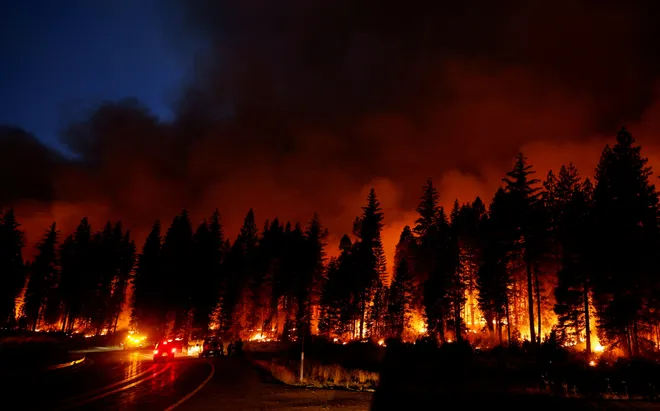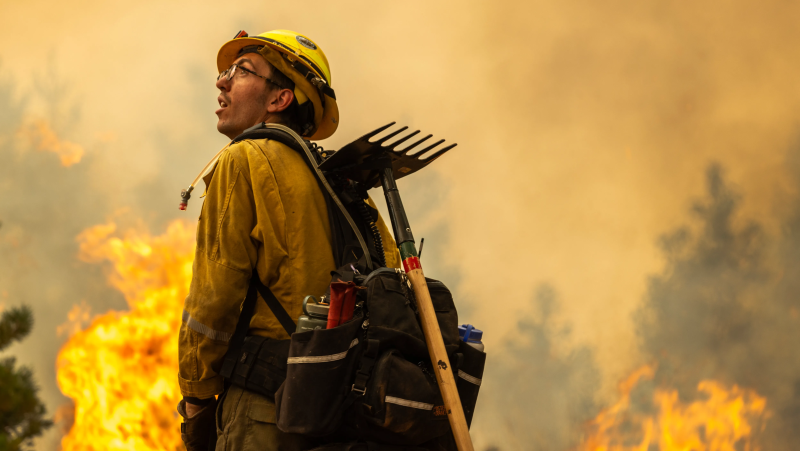California inferno still grows as firefighters make progress against Colorado blazes
Firefighters in Colorado made progress in the battle against several wildfires that broke out along the foothills of the Rocky Mountains this week as emergency crews in California struggled to put out one of the largest blazes in state history.
Fueled by a persistent drought and stretches of intense heat, four wildfires broke out between Monday and Wednesday along the Front Range, which runs from central Colorado into Wyoming, passing near several major cities including Denver. The fires grew rapidly and encroached on populated areas, forcing hundreds of people to flee. Several dozens of homes have been destroyed, officials said.
The Alexander Mountain Fire, the largest of the blazes, has scorched 8,134 acres of land west of the city of Loveland. Firefighters have contained it by 5% as of Friday morning, while officials have closed major roads, issued several mandatory evacuations and adopted fire restrictions, according to the National Interagency Fire Center.

In north Boulder County, firefighters contained the southern edge of the Stone Canyon Fire, which has destroyed at least five homes and killed one person near Rocky Mountain National Park, officials said. The blaze has engulfed over 1,500 acres some 20 miles north of Denver. And while it remains the second largest fire in the state, the progress allowed residents in several subdivisions to return to their homes.
"We're feeling really good about this," Nathan Hallam, the fire incident commander on scene, said in a video posted on X. He added that he anticipated the fire to shrink significantly through the weekend.
The consistent 90-degree temperatures and steep terrain have proved dangerous for firefighters as they attempt to quell the flames. In Jefferson County, at least five firefighters were injured on Wednesday, including four who suffered heat exhaustion, said Mark Techmeyer, a spokesperson for the county sheriff's office.
Meanwhile, more than 6,700 fire personnel continue to battle northern California's Park Fire, the fourth largest in state history. The inferno, which has been burning since July 24, has swallowed 614 square miles, an area larger than New York City. Some 25,000 people have fled their homes as the blaze has torched over 540 houses, businesses and other structures, according to Cal Fire.

Scars from historic blaze may blunt growth of spreading wildfire
With fire crews trying to protect structures and critical infrastructure on the western, southern and eastern edges of the Alexander Mountain Fire, officials are hoping the northern edge will run out of fuel as it moves into the burn scar from the 2020 Cameron Peak Fire.
That fire, the largest ever in Colorado, burned 326 square miles over more than four months, threatening but not quite reaching the town of Masonville and neighborhoods just west of Horsetooth Reservoir.
The northern edge of the Alexander Mountain Fire is burning southwest of Masonville, and fire crews are working to build a containment line that will keep it from moving east toward homes in that area and tie into the fuel break to the north that they believe the Cameron Peak Fire burn scar will provide, said Jayson Coil, operations section chief for Southwest Area Incident Management Team 1.
“We have a limited number of resources, so if there’s an area we don’t think the fire’s willing to move through, then it prevents us from having to commit resources there,” Coil said at a media briefing late Thursday afternoon.
– Kelly Lyell, the Coloradoan
Large fires rage on in California
As of Thursday, more than 700 structures across California had been destroyed by the Park Fire, as fuel for the flames remained dry and susceptible, Cal Fire said.
"Heavy fuels continue to exhibit near record-level low moistures and are very receptive to fire," the agency said Friday.
The massive Park Fire was burning more than 397,000 acres and was 24% contained.
After starting in Chico, California, the Park Fire has spread north through gulches and canyons, impacting cities like Red Bluff and other mountain communities.
Further south, a group of other large fires continue to burn in the hills about 100 miles north of Los Angeles. The group, which includes the Borel Fire, is burning more than 90,000 acres and is nearly 50% contained, according to Cal Fire.
Fire officials warn of continued summer heat
National forecasters are warning temperatures will continue to be above average through November, and that fall in much of the U.S. could feel like a “second summer.”
In the western U.S., the heat has rapidly created dry fuel for wildfires in California and the northwest, and August and September are expected to bring more “above normal” fire conditions, according to the National Interagency Fire Center in Boise, Idaho.
The most recent report from the group said even larger areas of the western U.S. are expected to face the fire risks compared to the geographic outlook published just one month ago.
The findings come after temperature records were broken in July in Palm Springs, California, and Las Vegas, which reached 124 and 120 degrees Fahrenheit, the report said.
Contributing: Reuters
Disclaimer: The copyright of this article belongs to the original author. Reposting this article is solely for the purpose of information dissemination and does not constitute any investment advice. If there is any infringement, please contact us immediately. We will make corrections or deletions as necessary. Thank you.



